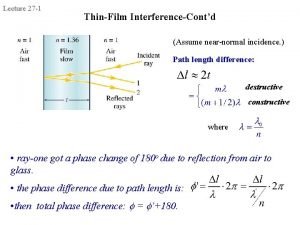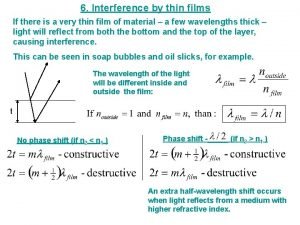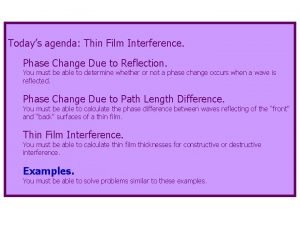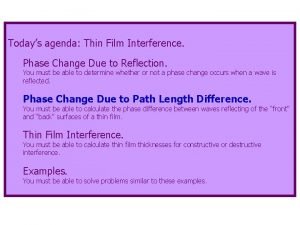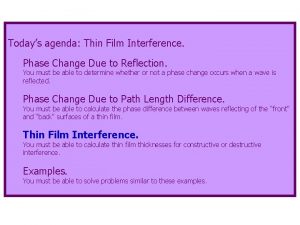Todays agenda Thin Film Interference Phase Change Due




- Slides: 4

Today’s agenda: Thin Film Interference. Phase Change Due to Reflection. You must be able to determine whether or not a phase change occurs when a wave is reflected. Phase Change Due to Path Length Difference. You must be able to calculate the phase difference between waves reflecting of the “front” and “back” surfaces of a thin film. Thin Film Interference. You must be able to calculate thin film thicknesses for constructive or destructive interference. Examples. You must be able to solve problems similar to these examples.

Thin Film Interference: Effect of Path Length Difference Example: light of wavelength 600 nm in air is perpendicularly incident on a piece of glass 4. 1 µm thick. The index of refraction of glass is 1. 5. Some of the light is reflected off the “back” surface of the glass. How many light waves are contained along the path of this light through the glass? Air Glass Air t …andenters Light …passes exits. through back the glass… the through glassthe andglass… reflects off the “back” surface… passes through offthe front Some probably reflects back into thesecond glass, glass but surface, buttalking we areabout not talking about that light. we are not that light.

Thin Film Interference: Path Length Difference How many light waves are contained along the path of this light through the glass? How many “waves” can fit in the path of length 2 t? Air Glass Air t

Thin Film Interference: Path Length Difference Are the outgoing waves in phase or out of phase with the incoming waves Note: if you look down at the glass, your eye sees only the reflected waves; you will not see interference of the incident and reflected waves, so you are not being asked if interference between incident and reflected waves will take place. Air Glass t Air The outgoing waves would differ in phase by ½ wavelength from the incoming waves… …except that you must also consider phase shift due to reflection (so we can’t give the answer just yet).
